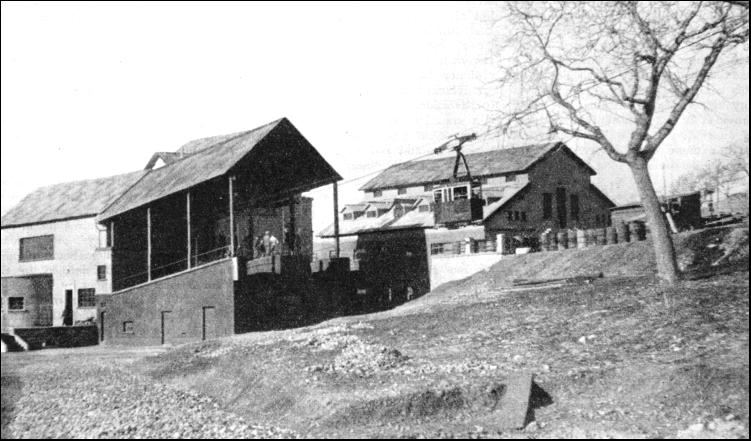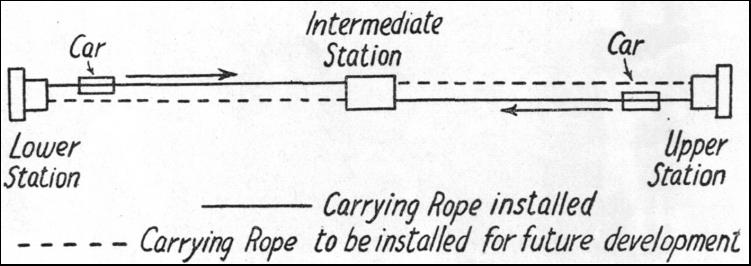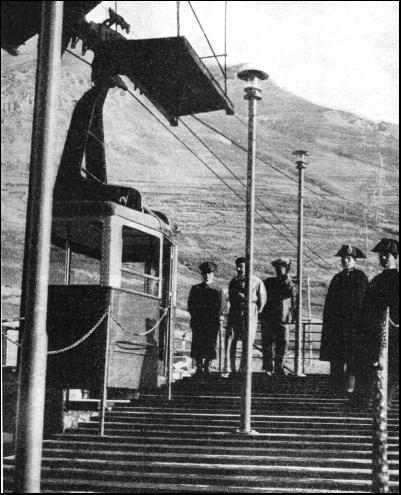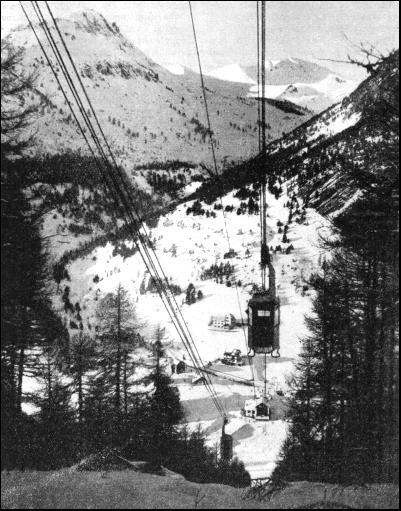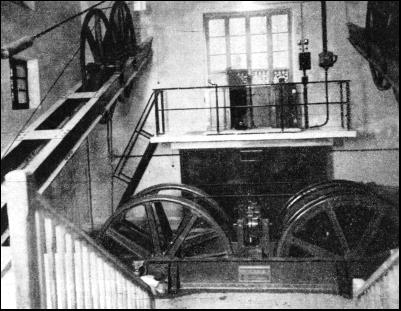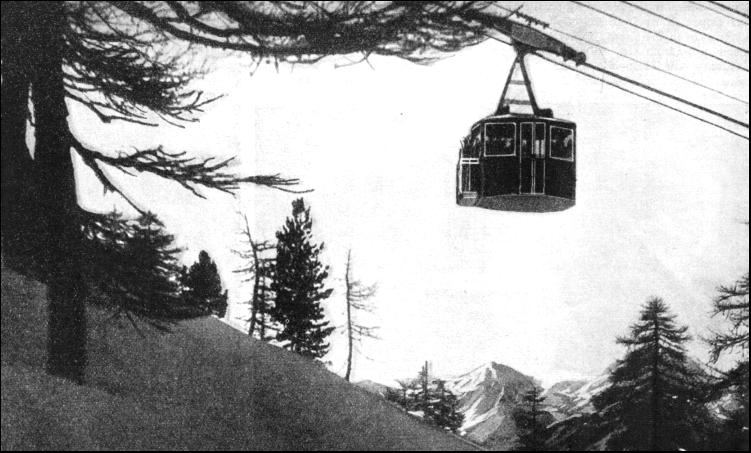|
|
WE are accustomed, when talking of Italy, to visualize a country of eternal sunshine and warmth. It seems almost incongruous and disappointing to find in the centre of Italy, within easy motoring distance of Rome, a high mountain range scored by perennial glaciers. This is the range of the Abbruzzian Apennines, where for nearly six months of the year wide stretches of the mountain slopes are covered with deep snow which attracts thousands of ski enthusiasts. The great development of skiing which has taken place during recent years, in Italy as elsewhere, has been responsible for the opening up of new districts, which are best reached by that most modern means of transport—the aerial ropeway. On this page attention will be given to the mechanical side of these railways through the air. The two Italian ropeways about to be described arc the latest to be completed at the time of writing. Although they are both built on the same system (Ceretti and Tanfani), they present an interesting contrast as typical examples of the long-distance and short-distance aerial ropeway.
The Gran Sasso is the highest group of Italian mountains south of the Alps. It is situated almost in the centre of the Apennines. The Apennine range begins above Ventimiglia, the frontier town on the Italian Riviera, sweeps westward in a curve behind Genoa, and turns south-west, traversing the whole peninsula almost in its centre. The Gran Sasso is a compact group of mountains rising in one mass, uninterrupted by passes or valleys, to a height exceeding 8,200 ft. It culminates in Monte Corno (9,560 ft.), about thirteen miles northeast of Aquila, the chief town of the province of Abbruzzi e Molise. This province is one of the most picturesque in Italy. Aquila lies on the railway from Sulmona to Terni, but it is more easily reached by road from Rome to Assergi, a few miles north of Aquila. The distance from Rome to Assergi is ninety-nine and a half miles. Close to Assergi, which lies 3,625 ft. above the sea, is the lower terminus of the aerial ropeway to the Campo Imperatore at an altitude of 6,929 ft. The difference in level is therefore 3,304 ft. The length of the aerial ropeway is 3,543 yards, or two miles twenty-three yards. The ropeway has several interesting features. The engineers have adopted a novel plan, which, while reducing the initial outlay, permits the doubling of the capacity of the line at a small additional expense. The line has accordingly been divided into two independent similar sections with an intermediate station. Each section has its own independent carrying rope, but there is only one traction and brake rope for both sections. The cars travel on the "jig-back" system in opposite directions. and meet at the intermediate station, where passengers change from one car to the other. The car on the lower section returns to the lower terminus. while the other car returns to the upper terminus. In the event of the increase of traffic necessitating the doubling of the capacity of the line, this could easily be done. The engineers would merely prolong the carrying rope of each section from the lower terminus to the intermediate station and thence, on the other side of the section, to the upper station, and add a second car on either side of the line. As the structural and mechanical part of the whole plant has been built with a view to such an increase, the above additions and the installation of one supplementary motor would cost relatively little.
The carrying ropes are supported by five steel lattice supports, three of which are in the lower section. The maximum span of 1,012 ft. is in the upper section. The height of the supports varies according to their position, the maximum being 102 ft. The carrying ropes of the two sections are equal in length. The ropes of the lower and the upper sections are anchored in the lower and upper terminus stations respectively. Both are kept taut by tension counterweights suspended in wells, which have been built in the intermediate station. The carrying rope has a diameter of 2-3/64 in. and is made up of 133 wires. The breaking strength is about 190 tons. The traction rope consists of six strands of nineteen wires over a hemp core and has a diameter of 15/16 in., the breaking strength being 37 tons. It is fixed to the cars at the ends facing the upper station. The ballast rope of six strands of twelve wires has a diameter of 25/32 in. and is fixed at the rear of the cars. The braking rope is a characteristic feature of the Ceretti and Tanfani system. It forms a closed circuit between the upper and lower termini. It is wound round a separate pulley in the lower station, and the tension is kept constant by counterweights at the upper station. The braking rope moves at the same speed, and in the same direction as the traction rope, running through the brake clutches, which are normally kept open by the effect of the tension of the traction and ballast ropes. When for any reason the tension of either of these two ropes falls below the predetermined limit, the brake clutches close tightly on the braking rope. This action simultaneously operates the electro-magnetic brake of the driving plant and brings it to a standstill. Even if the traction rope breaks, the cars are still able to run, since by the above arrangement the braking rope automatically assumes the function of the traction rope Should this occur the electro-magnetic brake is switched off by the operator.
The lower station comprises a shed with the arrival and departure platforms, and an adjoining building which contains the waiting-rooms, buffet, restaurant, staff living accommodation, and the machinery hall. This hall contains a huge reinforced concrete pulley, lined with hardwood. The carrying rope is wound several times over this pulley before being fixed to a steel structure anchored in a heavy foundation of reinforced concrete. This system permits the running off of short lengths of the carrying rope for the purpose of shifting the positions of those points on the rope which are subjected to heavy strains. The life of the rope is thus prolonged. The traction and braking ropes are wound round large pulleys provided with roller guides and connected with the tensioning counterweights. The upper station houses the driving machinery, which is arranged in a hall 90 ft long and 30 ft. wide. The carrying, traction, and braking ropes are anchored here in the same way as in the lower station. The driving plant consists of the motor, connected with the geared driving shaft, which engages through the gear transmission the main pulley and the counter pulley. Two sets have been installed, one acting as reserve. Each set is equipped with two hand brakes, two electro-magnetic, and two automatic oil brakes. The operator's cabin is placed on a raised structure above the machinery near the platforms, and is provided with a large window, so that the operator can overlook the platforms and the whole line. The operator has in front of him the controllers, the handbrake levers, the line indicator which shows the exact position of the cars, a telephone, measuring apparatus, and so forth. The electric installation consists of two similar groups which are used alternately. Each group comprises a 110 h.p. Diesel motor, a D.C. dynamo at 200-220 volts of the normal continuous capacity of 40 kW, the dynamo brake, a small exciter dynamo, and the 47 h.p. traction motor. The main dynamo is connected on the Ward Leonard system with the traction motor, which runs at 750 revolutions per minute. Particular attention has been given to the safety and braking arrangements, and every possibility of mechanical failure and of human error has been considered.
The electro-magnetic brakes operate automatically in the event of failure of the current feeding the traction motor. Such an interruption may occur through a break-down in the motor or whenever the driver shuts off the current. The current is automatically switched off when the automatic brakes of the cars come into action. The automatic brakes of the driving plant operate whenever a car, before arriving at any of the three stations, has passed the distance margin at an excessive speed ; also when, through inattention of the driver, a car approaches any of the stations at an excessive speed. In fact, the brakes come into action whenever the speed on the line exceeds the normal service speed by more than twenty per cent. In each of the three stations, and on the steel support, special wind-speed indicators are fixed. These light powerful electric lamps to show whenever the pressure of the wind exceeds 4.1 lb. per square foot, the limit at which the service is allowed to be maintained under Government regulations. The passenger cars are built of light metal alloy. The upper part has large sliding windows which permit an uninterrupted view. The folding door opens inwards and is fitted with an automatic safety lock that closes when the car starts moving. A special steadying device attached to the suspension of the car prevents excessive oscillations and ensures perfectly smooth running. On the outside of the cars basket-like metal containers and projecting metal hoops serve to carry the skis. A trap-door in the roof gives access to the carriers ; thus the brake and the other mechanical parts can be inspected while the car is moving. Each car seats twenty passengers and the driver. A battery of accumulators lights the interior and the powerful headlights. The cars are connected by telephone with the stations and with one another. A special trolley is fixed on the roofs to collect the low-tension telephone current from the telephone wires. These are stretched above the carrying rope, and are supported by special insulators fixed on the steel trestles of the line. The Aerial Ropeway of the Gran Sasso was opened for traffic in October 1934. It may be regarded as a typical and up-to-date example of an aerial line. Nothing has been omitted to ensure the safety of the passengers. Not less interesting is the Aerial Ropeway from Clavières to Pian del Sole. This also is built on the Ceretti and Tanfani system, but its short length has made unnecessary the division into two sections and the erection of an intermediate station.
Clavières is a small Alpine village and one of the highest inhabited places in Italy. It lies at an altitude of 5,774 ft. above sea-level in the picturesque valley that slopes down from the Colle del Monginevro in Piedmont. Clavières is eleven miles from the railway station of Oulx. on the Turin-Modane line. A regular motor service connects Oulx with Clavières by the road that Napoleon built over the Monginevro when he undertook the conquest of Italy. Oulx is seven miles from Bardonecchia, at the Italian mouth of the Mont Cenis Tunnel. This was the first tunnel to be driven through the Alps, having been built in 1856-72. People speak in Italy of "the snow of Clavières" in the same manner as they speak of the "sands of the Lido," or of "the blue waters of Capri." There is a good reason for thus describing the superlative quality of the snow of this region. The natural causes responsible for its excellence are not known, as the matter has never been scientifically investigated. We can only surmise that it may be due to some unusual combination of the exhalations of the soil, of the chemical composition of the evaporating water, which turns to snow, and of a particular degree of atmospheric humidity. But whatever the causes, the snow of Clavières is considered to be the best that can be found on the southern slopes of the Alps. Expert skiers are very particular about the quality of the snow, and it is a surprising and fascinating experience for the beginner to listen to a conversation of a group of expert skiers on the merits of this or that "run." It was, therefore, only natural that when the line from Clavières was projected the advice of several famous expert skiers was sought to ascertain the best run to which the aerial ropeway should be brought. The decision fell on the Pian del Sole—the Plain of the Sun. It was here, in seemingly eternal sunshine, that the upper station of the line was built. The length of the aerial ropeway is 973 yards. The difference in level between the two stations of Clavières and Pian del Sole is 984 ft. The driving plant is installed in the lower station. The upper station contains the tensioning devices for keeping the ropes taut. Along the line two intermediate steel lattice supports carry the rollers over which the traction and brake ropes run, and the shoes over which the carrying rope is laid. The rollers have, as usual, interchangeable rubber lining so that the wear and tear of the ropes shall be kept at a minimum. The steel supports are anchored in huge concrete blocks that are set deeply into the solid rock.
The ropeway is built on the "jig-back" system with two carrying ropes, one for ascending and the other for descending cars. These ropes are placed at a distance of from 13 ft. 1-1/2 in. to 17 ft. 3/4 in. from one another. The carrying ropes have a diameter of 1-29/64 in., and are anchored in the two stations. They are kept at the requisite tension by counterweights consisting of concrete blocks suspended in wells. The traction rope is fixed to the valley sides of the two cars and the ballast rope to the opposite side of the cars. Both ropes are constructed of stranded wires over a hemp core, and have a diameter of 25/32 in. They are wound over separate pulleys of 6 ft. 7 in. diameter and carried over the driving pulley, which has a diameter of 7 ft. 4-5/8 in. The pulley is provided with two leather-lined grooves. On the shaft of the driving pulley a toothed wheel is mounted which engages, through two geared axles and the gear reducer, the shaft of the electric motor. The counter pulley has the same diameter as the driving pulley. The three-phase motor, of a normal capacity of 50 h.p., can drive the cars at a speed of 13 to 16 ft. per second. A Diesel engine of 20 h.p. has been installed for use in the event of breakdown of electric current. It is connected through gear transmission with the driving pulley. The passenger cars seat sixteen passengers and the driver, and are built of light metal alloy. Their construction is otherwise identical to that of the cars on the Gran Sasso line, with the exception of the arrangements for carrying the skis. Each car has at the rear a large metal basket which occupies its whole width. The normal speed of the cars is 14 ft. 9 in. per second, and the journey takes three and a half minutes. A hundred and sixty passengers can thus be carried per hour in either direction. The success of the Clavières aerial ropeway, which has attracted large numbers of visitors, has led the Italian State Railways to provide a special rail-car service from Ventimiglia, on the Franco-Italian frontier, to Oulx, especially for the benefit of the residents on the French and Italian Riviera. A new type of rail-car has been constructed, having a length of 73-1/2 ft., a weight, when empty, of 20.2 tons, and seating accommodation for forty-eight passengers. They are driven by two 120 h.p. Fiat petrol engines. The journey from Ventimiglia to Oulx takes four hours five minutes, a good performance in view of the mountainous country and the steepness of the gradients. From Ventimiglia to Limone a difference in level of 3,251 ft. has to be negotiated over a distance of forty-two and a quarter miles, and from Turin to Oulx forty-seven and a quarter miles, the difference in level is 2,713 ft.
Many thanks for your help
|
   Share this page on Facebook - Share  [email protected] |

